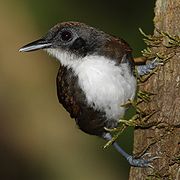
Ant-follower
Encyclopedia

Bird
Birds are feathered, winged, bipedal, endothermic , egg-laying, vertebrate animals. Around 10,000 living species and 188 families makes them the most speciose class of tetrapod vertebrates. They inhabit ecosystems across the globe, from the Arctic to the Antarctic. Extant birds range in size from...
s that feed by following swarms of army ant
Ecitoninae
Most New World army ants belong to the subfamily Ecitoninae. This subfamily is further broken into two groups in the New World, the tribes Cheliomyrmecini and Ecitonini. The former contains only the genus Cheliomyrmex, and the tribe Ecitonini contains four genera, Neivamyrmex, Nomamyrmex, Labidus,...
s and take prey flushed by those ants. The best known ant-followers are 18 species of antbird
Antbird
The antbirds are a large family, Thamnophilidae, of passerine birds found across subtropical and tropical Central and South America, from Mexico to Argentina. There are more than 200 species, known variously as antshrikes, antwrens, antvireos, fire-eyes, bare-eyes and bushbirds...
in the family Thamnophilidae, but other families of birds may follow ants including thrushes
Thrush (bird)
The thrushes, family Turdidae, are a group of passerine birds that occur worldwide.-Characteristics:Thrushes are plump, soft-plumaged, small to medium-sized birds, inhabiting wooded areas, and often feed on the ground or eat small fruit. The smallest thrush may be the Forest Rock-thrush, at and...
, chat
Chat (bird)
Chats are a group of small Old World insectivorous birds formerly classed as members of the thrush family Turdidae, but now considered Old World flycatchers....
s, ant-tanagers, cuckoo
Cuckoo
The cuckoos are a family, Cuculidae, of near passerine birds. The order Cuculiformes, in addition to the cuckoos, also includes the turacos . Some zoologists and taxonomists have also included the unique Hoatzin in the Cuculiformes, but its taxonomy remains in dispute...
s, and woodcreeper
Woodcreeper
The woodcreepers comprise a subfamily of sub-oscine passerine birds endemic to the Neotropics. They have traditionally been considered a distinct family Dendrocolaptidae, but most authorities now place them as a subfamily of the ovenbirds...
s.
Ant followers may be obligate, meaning that they derive most of their diet by following ant swarms, or non-obligate, meaning they derive only some of their diet from this behaviour. Some species may feed extensively at ant swarms yet may not be obligate ant-followers, being able to and regularly feeding away from the swarms as well.
Many species of tropical ant
Ant
Ants are social insects of the family Formicidae and, along with the related wasps and bees, belong to the order Hymenoptera. Ants evolved from wasp-like ancestors in the mid-Cretaceous period between 110 and 130 million years ago and diversified after the rise of flowering plants. More than...
s form large raiding swarms, but the swarms are often nocturnal
Nocturnal animal
Nocturnality is an animal behavior characterized by activity during the night and sleeping during the day. The common adjective is "nocturnal"....
or raid underground. While birds visit these swarms when they occur, the species most commonly attended by birds is the Neotropical species Eciton burchellii
Eciton burchellii
Eciton burchellii is the predominant species of the genus Eciton and a type of New World army ant. Distinct in its expansive, highly organized swarm raids, it is often considered the archetypal species of "army ant" — so much that the term has become its common name — and remains one of...
, which is both diurnal and surface-raiding.
It was once thought that attending birds were actually eating the ants, but numerous studies in various parts of E. burchellii's range has shown that the ants act as beaters, flushing insects, other arthropods and small vertebrates into the waiting flocks of "ant-followers". Because E. burchellii is the only regular diurnal army ant specialised and regular ant-followers mostly occur in its Neotropical range, but Afrotropical birds do follow driver ants in the genus Dorylus
Dorylus
The army ant genus Dorylus, also known as driver ants, safari ants, or siafu, is found primarily in central and east Africa, although the range also extends to tropical Asia. The term siafu is a loanword from Swahili, and is one of numerous similar words from regional Bantu languages used by...
.
It was once suggested that the relationship between the obligate and regular ant-followers and the army ants, particularly Eciton burchellii, was mutualistic, with the ants benefiting by having the birds chase prey back down towards them. However experiments where ant-followers were excluded have shown that the foraging success of the army ants was 30% lower when the birds were present, suggesting that the birds' relationship was in fact parasitic. This has resulted in a number of behaviours by the ants in order to reduce kleptoparasitism
Kleptoparasitism
Kleptoparasitism or cleptoparasitism is a form of feeding in which one animal takes prey or other food from another that has caught, collected, or otherwise prepared the food, including stored food...
, including hiding of secured prey in the leaf litter and caching of food on trails. It has been suggested that the depressive effect of this parasitism slows the development of E. burchellii swarms and in turn benefits other ant species which are preyed upon by army ants.
Despite the easier availability of prey, ant-followers face an element of risk, as these small birds can be killed by four stings from fire ants.

